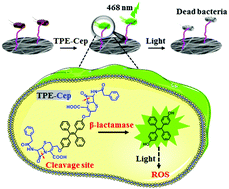当前位置:
X-MOL 学术
›
J. Mater. Chem. B
›
论文详情
Our official English website, www.x-mol.net, welcomes your
feedback! (Note: you will need to create a separate account there.)
Fibrous testing papers for fluorescence trace sensing and photodynamic destruction of antibiotic-resistant bacteria
Journal of Materials Chemistry B ( IF 6.1 ) Pub Date : 2020/02/26 , DOI: 10.1039/d0tb00002g Long Zhao 1, 2, 3, 4, 5 , Yuan Liu 1, 2, 3, 4, 5 , Zhanlin Zhang 1, 2, 3, 4, 5 , Jiaojun Wei 1, 2, 3, 4, 5 , Songzhi Xie 1, 2, 3, 4, 5 , Xiaohong Li 1, 2, 3, 4, 5
Journal of Materials Chemistry B ( IF 6.1 ) Pub Date : 2020/02/26 , DOI: 10.1039/d0tb00002g Long Zhao 1, 2, 3, 4, 5 , Yuan Liu 1, 2, 3, 4, 5 , Zhanlin Zhang 1, 2, 3, 4, 5 , Jiaojun Wei 1, 2, 3, 4, 5 , Songzhi Xie 1, 2, 3, 4, 5 , Xiaohong Li 1, 2, 3, 4, 5
Affiliation

|
The increasing prevalence of antibiotic-resistant bacteria needs rapid identification and efficient destruction routes. This study proposes testing paper derived from electrospun fibrous mats and aggregation-induced emission (AIE) probes for trace sensing and simultaneous destruction of antibiotic-resistant E. coli. Aptamers are conjugated on fibers for selective capture of E. coli, and the capture capability can be regenerated via rinsing with salt solution. Hydroxyl tetraphenylethene (TPE) is linked with two cephalosporin molecules to construct TPE-Cep probes, and the fluorescence emission is turned on specifically in the presence of β-lactamase, which is a critical marker for screening resistant bacteria. Fibrous mats are lit up only in the presence of antibiotic-resistant bacteria, and the fluorescence intensity changes could be statistically fitted into an equation for quantitative analysis. Fibrous strips display apparent color changes from blue to green for a visual readout of bacterial levels, and the limit of detection (LOD) is much lower than those of previous paper substrates. In addition, the TPE-Cep probes could produce reactive oxygen species (ROS) under room light illumination to kill the captured bacteria. Thus, the integration of aptamer-grafted electrospun fibers and functional AIE probes provides potential for selective capture, trace imaging and photodynamic destruction of antibiotic-resistant bacteria.
中文翻译:

纤维试纸,用于荧光痕量传感和对抗生素抗性细菌的光动力破坏
耐药性细菌的日益流行需要快速识别和有效的销毁途径。这项研究提出了一种由电纺纤维毡和聚集诱导发射(AIE)探针衍生的试纸,用于痕量感测和同时破坏抗药性的大肠杆菌。适体缀合在纤维上以选择性捕获大肠杆菌,捕获能力可通过用盐溶液冲洗。羟基四苯乙烯(TPE)与两个头孢菌素分子连接以构建TPE-Cep探针,并且在存在β-内酰胺酶的情况下特异性地开启荧光发射,β-内酰胺酶是筛选抗性细菌的关键标志物。仅在存在抗生素抗药性细菌的情况下才照亮纤维毡,并且可以将荧光强度的变化统计地拟合到方程中进行定量分析。纤维条显示出从蓝色到绿色的明显颜色变化,以可视方式读出细菌水平,并且检测极限(LOD)远低于以前的纸张基材。此外,TPE-Cep探针可在室内光照下产生活性氧(ROS),以杀死捕获的细菌。从而,
更新日期:2020-04-01
中文翻译:

纤维试纸,用于荧光痕量传感和对抗生素抗性细菌的光动力破坏
耐药性细菌的日益流行需要快速识别和有效的销毁途径。这项研究提出了一种由电纺纤维毡和聚集诱导发射(AIE)探针衍生的试纸,用于痕量感测和同时破坏抗药性的大肠杆菌。适体缀合在纤维上以选择性捕获大肠杆菌,捕获能力可通过用盐溶液冲洗。羟基四苯乙烯(TPE)与两个头孢菌素分子连接以构建TPE-Cep探针,并且在存在β-内酰胺酶的情况下特异性地开启荧光发射,β-内酰胺酶是筛选抗性细菌的关键标志物。仅在存在抗生素抗药性细菌的情况下才照亮纤维毡,并且可以将荧光强度的变化统计地拟合到方程中进行定量分析。纤维条显示出从蓝色到绿色的明显颜色变化,以可视方式读出细菌水平,并且检测极限(LOD)远低于以前的纸张基材。此外,TPE-Cep探针可在室内光照下产生活性氧(ROS),以杀死捕获的细菌。从而,











































 京公网安备 11010802027423号
京公网安备 11010802027423号